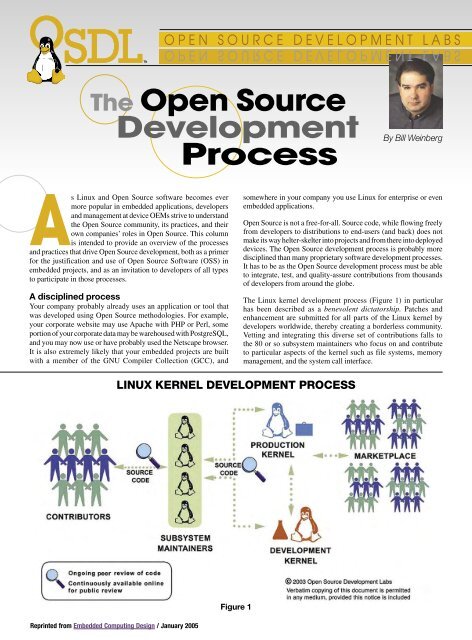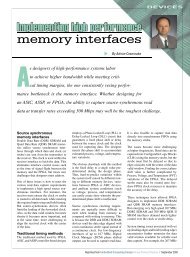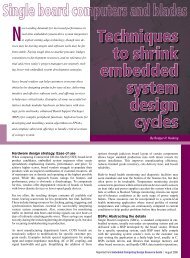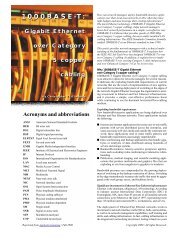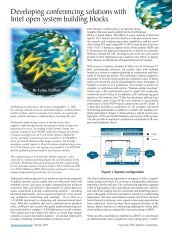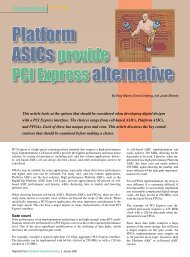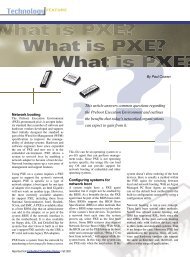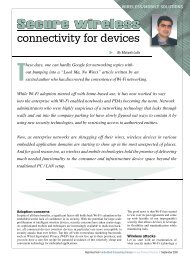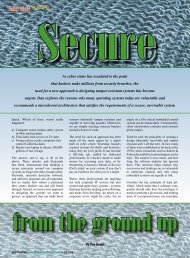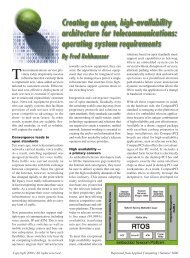OSDL - The Open Source Development Process - Embedded ...
OSDL - The Open Source Development Process - Embedded ...
OSDL - The Open Source Development Process - Embedded ...
Create successful ePaper yourself
Turn your PDF publications into a flip-book with our unique Google optimized e-Paper software.
<strong>The</strong> <strong>Open</strong> <strong>Source</strong><br />
<strong>Development</strong><br />
<strong>Process</strong><br />
As Linux and <strong>Open</strong> <strong>Source</strong> software becomes ever<br />
more popular in embedded applications, developers<br />
and management at device OEMs strive to understand<br />
the <strong>Open</strong> <strong>Source</strong> community, its practices, and their<br />
own companies’ roles in <strong>Open</strong> <strong>Source</strong>. This column<br />
is intended to provide an overview of the processes<br />
and practices that drive <strong>Open</strong> <strong>Source</strong> development, both as a primer<br />
for the justification and use of <strong>Open</strong> <strong>Source</strong> Software (OSS) in<br />
embedded projects, and as an invitation to developers of all types<br />
to participate in those processes.<br />
A disciplined process<br />
Your company probably already uses an application or tool that<br />
was developed using <strong>Open</strong> <strong>Source</strong> methodologies. For example,<br />
your corporate website may use Apache with PHP or Perl, some<br />
portion of your corporate data may be warehoused with PostgreSQL,<br />
and you may now use or have probably used the Netscape browser.<br />
It is also extremely likely that your embedded projects are built<br />
with a member of the GNU Compiler Collection (GCC), and<br />
Reprinted from <strong>Embedded</strong> Computing Design / January 2005<br />
O P E N S O U R C E D E V E L O P M E N T L A B<br />
O P E N S O U R C E D E V E L O P M E N T L A B S<br />
S<br />
By Bill Weinberg<br />
somewhere in your company you use Linux for enterprise or even<br />
embedded applications.<br />
<strong>Open</strong> <strong>Source</strong> is not a free-for-all. <strong>Source</strong> code, while flowing freely<br />
from developers to distributions to end-users (and back) does not<br />
make its way helter-skelter into projects and from there into deployed<br />
devices. <strong>The</strong> <strong>Open</strong> <strong>Source</strong> development process is probably more<br />
disciplined than many proprietary software development processes.<br />
It has to be as the <strong>Open</strong> <strong>Source</strong> development process must be able<br />
to integrate, test, and quality-assure contributions from thousands<br />
of developers from around the globe.<br />
<strong>The</strong> Linux kernel development process (Figure 1) in particular<br />
has been described as a benevolent dictatorship. Patches and<br />
enhancement are submitted for all parts of the Linux kernel by<br />
developers worldwide, thereby creating a borderless community.<br />
Vetting and integrating this diverse set of contributions falls to<br />
the 80 or so subsystem maintainers who focus on and contribute<br />
to particular aspects of the kernel such as file systems, memory<br />
management, and the system call interface.<br />
LINUX KERNEL DEVELOPMENT PROCESS<br />
Figure 1
Advancing versions of these subsystems are rolled up into patch<br />
sets that ultimately form experimental kernel versions (in the past,<br />
odd numbered kernel releases like 2.3.x and 2.5.x). When Linus<br />
Torvalds and his team at kernl.org are convinced that Linux kernel<br />
technology has advanced and matured sufficiently for commercial<br />
deployment, a new production kernel is born and handed off for<br />
testing to production kernel maintainers (for example, Marcelo<br />
Tosati for 2.4 and Andrew Morton for 2.6). It is normally from<br />
these stable production kernels that distribution suppliers build<br />
their GNU/Linux OS platforms. For the enterprise: Red Hat,<br />
SuSE, and others. For the embedded domain: MontaVista, TimeSys,<br />
Wind River, and others.<br />
OSS code origins<br />
Let us examine two origins of <strong>Open</strong> <strong>Source</strong> code:<br />
■ <strong>Open</strong> <strong>Source</strong> code from new projects<br />
■ <strong>Open</strong> <strong>Source</strong> code integration into mature projects<br />
<strong>Open</strong> <strong>Source</strong> code from new projects<br />
<strong>Open</strong> <strong>Source</strong> software projects are initiated in the same manner<br />
as proprietary projects – from a developer’s inspiration, or more<br />
formally, in response to requirements expressed by and collected<br />
from end-users.<br />
OSS departs radically from traditional commercial software in that<br />
its inception need not take place within the confines of a traditional<br />
engineering organization. Sometimes new code is written from<br />
scratch, and other times, a piece of existing code is re-licensed under<br />
an <strong>Open</strong> <strong>Source</strong> license and released as a community project.<br />
Some OSS projects, such as applications or middleware, are<br />
entirely free-standing. Others exist as patches to the Linux kernel<br />
or other OS components – usually device drivers, I/O subsystems,<br />
alternate schedulers, and other systems components. A project<br />
can exist indefinitely as an independent effort, and is useful as<br />
long as its maintainers update it to support current libraries and<br />
kernel versions.<br />
If a project shows exceptional merit and broad utility, it can also<br />
be picked up by the Linux kernel maintainers and be integrated<br />
into the mainstream OS. Such examples include the adoption<br />
of the National Security Agency (NSA) Secure SE Linux as a<br />
standard build option in the 2.6 Linux kernel, and the incorporation<br />
of the Pre-emptible Linux Kernel Patch into the 2.5 and later<br />
production kernels. More typical examples are the hundreds of<br />
drivers developed by hardware vendors for their devices and later<br />
integrated into mainstream kernel trees.<br />
<strong>Open</strong> <strong>Source</strong> code integration into<br />
mature projects<br />
Larger, mature projects continue to evolve over time and benefit<br />
from the contributions of both core team developers as outside<br />
submitters. Understanding the path that new submissions follow is<br />
instructive for organizations hoping to participate in <strong>Open</strong> <strong>Source</strong><br />
S I D E B A R<br />
<strong>OSDL</strong> Role in <strong>Open</strong> <strong>Source</strong><br />
<strong>The</strong> <strong>OSDL</strong> participates in <strong>Open</strong> <strong>Source</strong> development<br />
in four distinct capacities.<br />
1<br />
<strong>OSDL</strong> Initiatives<br />
First, and most visibly, <strong>OSDL</strong> initiatives, promoted<br />
by and for member companies, collect and refine<br />
end-user requirements for each of the target areas:<br />
Carrier Grade, Data Center, and Desktop Linux.<br />
<strong>The</strong>se requirements are mapped against the current<br />
capability set of Linux and its stack at any given<br />
moment in time with two outcomes: the provision of<br />
specifications and capabilities lists to distribution<br />
providers, and the fostering of new community<br />
development to fill gaps in Linux capabilities.<br />
2<br />
Performance and Regression Testing<br />
Less visibly, the <strong>OSDL</strong> hosts a massive testing effort<br />
for both experimental and production versions of<br />
the Linux kernel. This test bed can also be applied to<br />
combinations of kernel builds and patch sets using<br />
the <strong>OSDL</strong> Scalable Test Platform (STP) combined<br />
with the Linux Patch Line Manager (PLM). <strong>OSDL</strong><br />
members and associates can upload patches and<br />
leverage STP online at the <strong>OSDL</strong> website.<br />
3<br />
<strong>OSDL</strong> Member Contributions to<br />
<strong>Open</strong> <strong>Source</strong><br />
In response to <strong>OSDL</strong> initiatives and other<br />
organizational imperatives, the over 60 members of<br />
the <strong>OSDL</strong> make substantial contributions to Linux<br />
and to other <strong>Open</strong> <strong>Source</strong> projects in both enterprise<br />
and embedded areas. Founding members include<br />
IBM, Intel, HP, CA, Fujitsu, Hitachi, and NEC.<br />
4<br />
Direct Participation in OSS <strong>Development</strong><br />
<strong>OSDL</strong> staff members contribute directly to<br />
dozens of <strong>Open</strong> <strong>Source</strong> projects such as the<br />
Kernel, Asynchronous IO, Persistent Device<br />
Naming, Clustering, and Testing. <strong>The</strong> <strong>OSDL</strong> also<br />
compensates Linus Torvalds, and kernel maintainer<br />
Andrew Morton.<br />
Reprinted from <strong>Embedded</strong> Computing Design / January 2005<br />
Reprinted from <strong>Embedded</strong> Computing Design / January 2005
development, and for companies concerned about the integrity of<br />
the process (Figure 2).<br />
Newcomers to <strong>Open</strong> <strong>Source</strong> often speak of pushing code out to<br />
<strong>Open</strong> <strong>Source</strong>, but push is an inappropriate verb to describe the<br />
submission process. Individual contributors or organizations<br />
actually find it quite challenging to have their patches accepted<br />
into actual projects and distributions.<br />
To begin with, a patch must be well-formed, which means coded<br />
and packaged per the established <strong>Open</strong> <strong>Source</strong> conventions, and<br />
per the requirements of the given project. Moreover, a patch must<br />
be of sufficient merit or novelty to stand out from the dozens<br />
(or hundreds) of other proposed patches in front of a project<br />
maintainer.<br />
Once a submission actually makes it into a project, it will be<br />
exercised, tested, and scrutinized by that project’s user community.<br />
If it survives and becomes part of a project’s mainstream code, and<br />
the project is then picked up by a distribution, it will be subject<br />
to the integration, testing, and QA discipline that comprises that<br />
distribution’s added value.<br />
It should be noted that end-users have complete project control,<br />
because the inclusion of each specific project package in the<br />
distribution into their project is entirely discretionary. Because you<br />
have the project source code, you can always return to the project<br />
that accepted and built the code if the need arises.<br />
<strong>Open</strong> <strong>Source</strong> code quality assurance<br />
Quality assurance for <strong>Open</strong> <strong>Source</strong> code occurs at several points<br />
in the code lifecycle, and at multiple places in the <strong>Open</strong> <strong>Source</strong><br />
ecosystem. As described above, there exist three layers of purview<br />
over code submission and quality:<br />
■ Project<br />
■ Distribution<br />
■ End-user<br />
Reprinted from <strong>Embedded</strong> Computing Design / January 2005<br />
Figure 2<br />
At the project level, there is project-specific testing (including<br />
build-testing) that is carried out as part of the project lifecycle.<br />
At the same time, the project community joins with the project<br />
audience to engage in usability and performance testing.<br />
Project code integration into standard distributions is subject to both<br />
standards-based and supplier-specific testing, and the QA that each<br />
distribution team performs. In my own experience at an embedded<br />
distribution vendor, we performed standards-compliance testing<br />
(for example, LSB and POSIX), stability and robustness testing,<br />
real-time response and throughput benchmark testing, installation<br />
testing, and several other tests and QA checks. We also crosspollinated<br />
by comparing test results among our eight supported<br />
architecture families.<br />
<strong>The</strong> result of open source cooperation<br />
If you extend the test and QA process cooperation out to several<br />
dozen distribution suppliers, add the bug reports from hundreds<br />
of thousands of embedded and enterprise users and developers,<br />
and then add the rapid repair and integration that is the hallmark<br />
of <strong>Open</strong> <strong>Source</strong>, you have a virtualized and borderless QA team<br />
that outpaces and outscales even the largest proprietary software<br />
organization.<br />
Bill Weinberg brings more than 17 years embedded and open<br />
systems experience to his role as <strong>Open</strong> <strong>Source</strong> Architecture<br />
Specialist at the <strong>Open</strong> <strong>Source</strong> <strong>Development</strong> Labs. Bill can be<br />
contacted at bweinberg@osdl.org.<br />
<strong>OSDL</strong> – home to Linus Torvalds, the creator of Linux – is<br />
dedicated to accelerating the growth and adoption of Linux in the<br />
enterprise. Contact the <strong>OSDL</strong> directly for membership and lab<br />
usage information.<br />
<strong>Open</strong> <strong>Source</strong> <strong>Development</strong> Labs, Inc.<br />
12725 SW Millikan Way • Suite 400 • Beaverton, OR 97005<br />
Tel: 503-626-2455 • Fax: 503-626-2436<br />
Website: www.osdl.org<br />
CODE SUBMISSION AND AUDIT PATH


